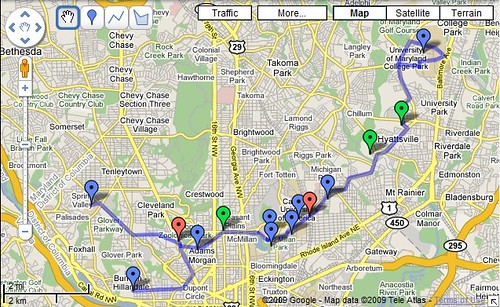Getting transit and development backwards
 Usually, transit comes first, then the real estate development. When the development isn't happening, it's often because it's in areas with less transit service compared to other areas. The solution to under-development is adding transit service.
Usually, transit comes first, then the real estate development. When the development isn't happening, it's often because it's in areas with less transit service compared to other areas. The solution to under-development is adding transit service.GGW has a post, "McMillan visions take shape," about presentations about development scenarios for the McMillan Reservoir site at North Capitol Street and Michigan Avenue in NW DC, on the border with NW and NE.

Sand filtration vessels, now unused, McMillan Reservoir, Washington, DC
There is a group of area residents who recommend a different course, mostly focused on park related use of the land. Because of the historic nature of this relic of the city's water treatment engineering systems, that isn't an unrealistic desire.
1. Generally, I don't agree necessarily when people fight development based on traffic concerns [especially in the center city where there is a robust transit network], except that
2. For some reason, DC doesn't feel it is necessary to require transportation enhancements as part of development projects, whereas
3. In Arlington or Alexandria, developments on the scale of McMillan Reservoir or the Armed Forces Retirement Home would trigger proffers for transportation enhancement, but such isn't the way things work in DC.
Plus, I had kept making this point of requiring transportation-related proffers during the Brookland Small Area Plan process in 2007/2008, but it never made it into the plan.
I have another entry from 2009, "Will streetcars really return to the Capital City?," about streetcars and the proposed crosstown streetcar line. I recommended building that line first, because there are no restrictions on overhead wires (an issue in the "L'Enfant City") and because at the heart, DC is a very conservative place and people need to see something like the streetcars in action before they can understand and embrace them--I don't see why it's so hard to see how streetcars work in a place like Portland, and imagine them here, but go figure, it's too hard for most people.

This line would provide connections to five subway stations: Woodley Park (red line), Columbia Heights (green line), Brookland (red line), West Hyattsville (green line), Prince George's Plaza (green line); six universities (Georgetown, American University, Howard University, Trinity University, Catholic University, and University of Maryland), the Washington Hospital Center, and the Adams Morgan and Columbia Heights commercial districts.
It would also provide economic reasons to intensfy land use development along Queens Chapel Road in Hyattsville, Avondale, and Mount Rainier and especially in the vicinity of the West Hyattsville station, which has a model transit oriented development plan, which has made almost no headway in influencing positive land use changes in that area.
----
But the funny thing in that post is how I missed the obvious point about the crosstown streetcar line promoting land use and land use intensification in DC. (I did list the McMillan Reservoir as one of the points on the Google Map.)
A crosstown streetcar line going east from Columbia Heights would boost a variety of development opportunities that for the most part are unrealized and will remain unrealized for decades:
- Bruce-Monroe Elementary School site at Irving Street and Georgia Avenue NW
- McMillan Reservoir
- Armed Forces Retirement Home (along Irving Street)
- rebuilding of the North Capitol and Irving Streets interchange into more of a traffic circle
- additional development at the Washington Hospital Center
- Catholic University land west of Harewood Road NE
- the proposed hotel spot at Michigan Avenue and Irving Street NE
- redevelopment of land at the Brookland subway station specifically
- as well as speeding up the development plans of the old "south campus" of Catholic University--south of Michigan Avenue, along Monroe Street, which is being developed by Abdo Development and Bozzuto Development
- redevelopment of land along the rail line north of the subway station, between Michigan Avenue and Taylor Street NE
Labels: real estate development, sustainable land use and resource planning, transit and economic development, transportation planning



0 Comments:
Post a Comment
<< Home